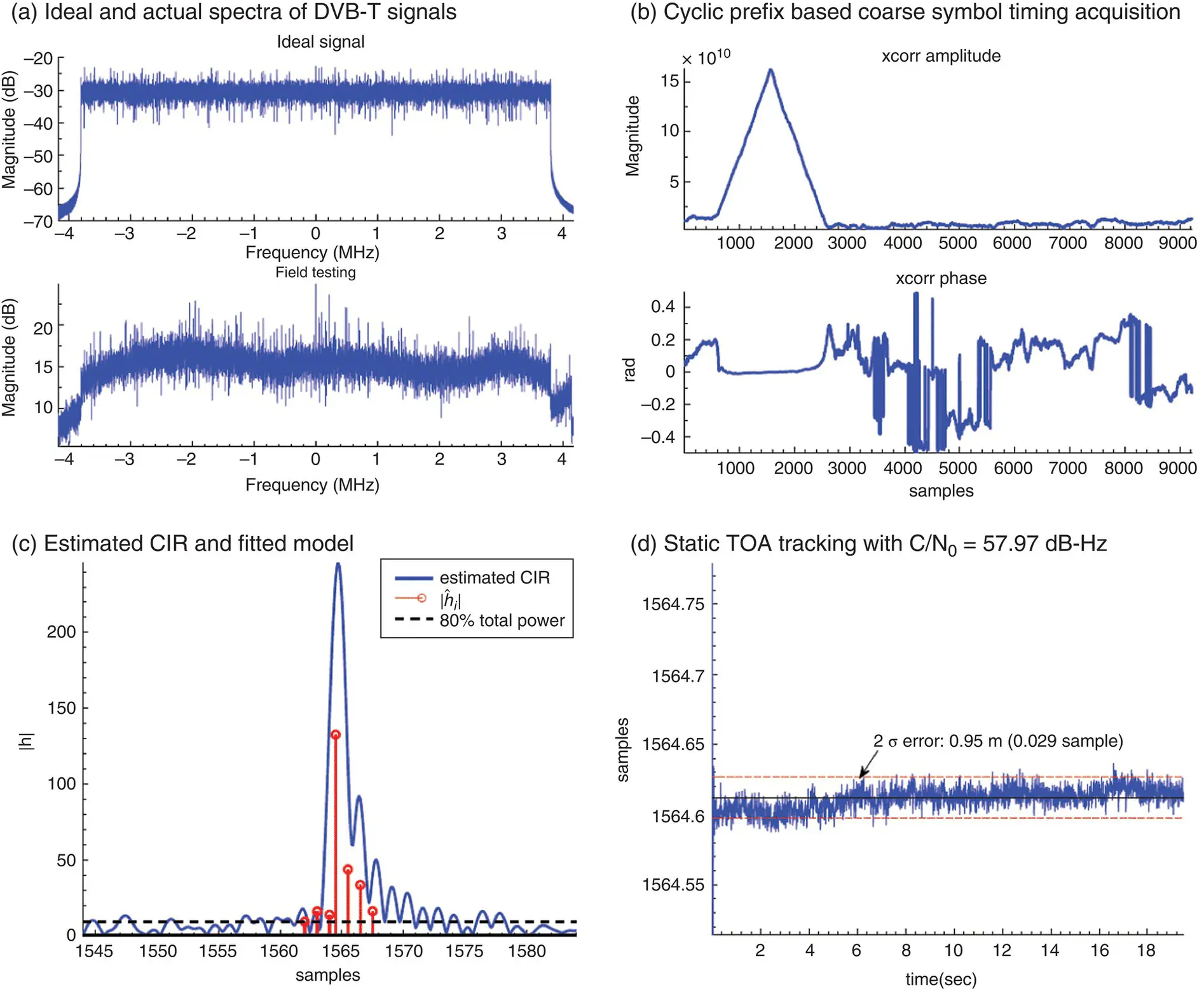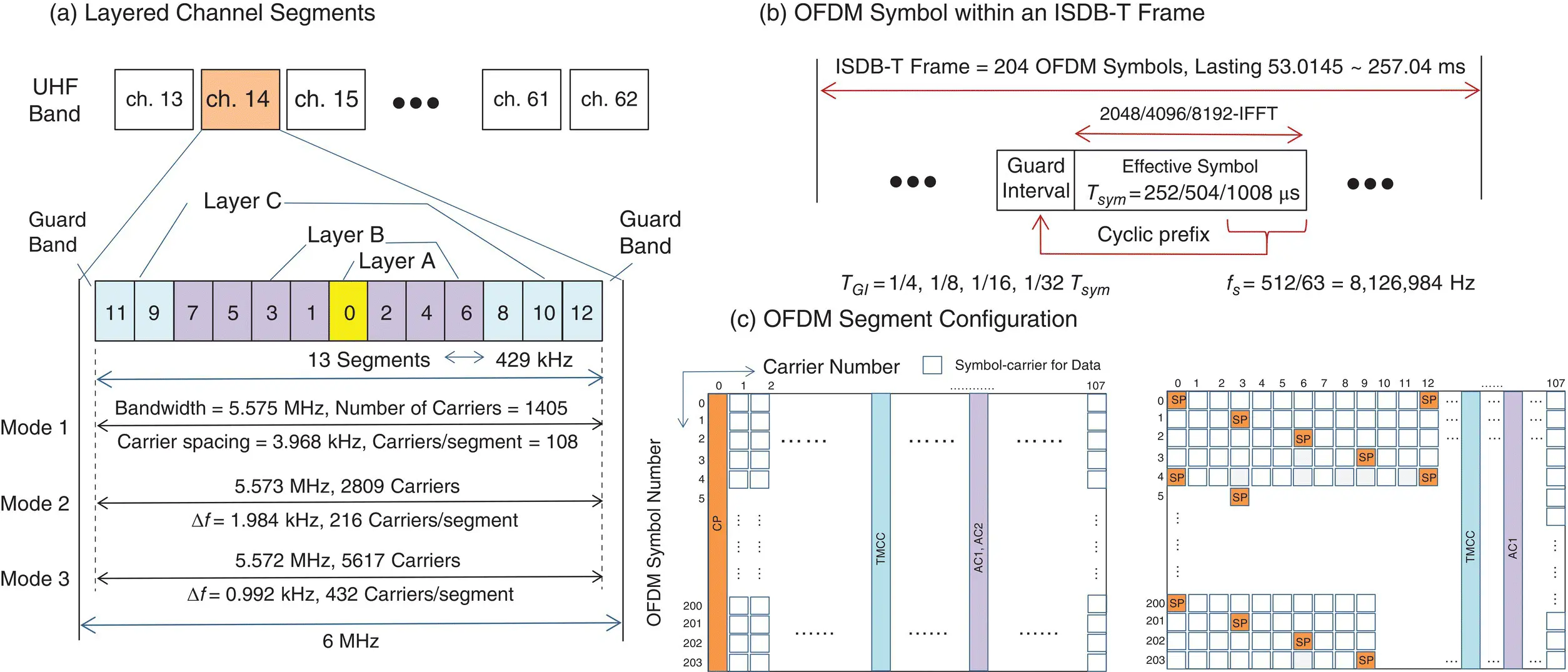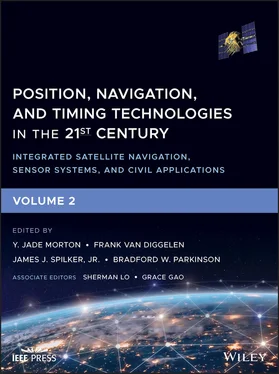In general, the carrier phase of OFDM signals is not tracked for at least two reasons. First, the dc component of most baseband OFDM symbols is a null subcarrier to avoid the effect of dc bias at reception. Second, generation and transmission of OFDM symbols are independent from one symbol to the next. As a result, no phase continuity is required to be maintained at any subcarriers. As analyzed earlier, for communications, demodulation of OFDM symbols with cyclic prefix is tolerant to small timing errors and depends on the relative phase at data subcarriers, which can be easily calibrated with the help of pilot subcarriers. However, the OFDM signaling adopted by DVB‐T retains the dc component. Besides, the cyclic prefix duration is specified in such a way that a whole number of cycles is ensured for the middle carrier [44]. It happens in DVB‐T that the middle carrier is assigned as a continual pilot subcarrier, which has a constant value across OFDM symbols. As a result, the baseband center frequency (dc component) has no phase discontinuity, which gives rise to the opportunity for carrier phase tracking. Carrier phase tracking has the potential to provide more accurate timing for ranging and ultimately for positioning than cross‐correlation of cyclic prefix and pilot subcarriers currently used for coarse and fine TOA estimation, respectively. The possibility of carrier phase tracking for DVB‐T signals was recently shown in [62] with in‐the‐air DVB‐T signals collected in experimental tests.
40.2.3 ISDB‐T Signals for Timing and Ranging
The Terrestrial Integrated Service Digital Broadcasting (ISDB‐T) is one of the earliest standards for digital TV, digital audio, and data, developed by Japan’s Association of Radio Industries and Business (ARIB) [63]. Also adopting OFDM, ISDB‐T groups its subcarriers within a transmission channel into 13 segments, which explains the name: band segmented transmission (BST‐OFDM). Thus, ISDB‐T supports hierarchical transmission using hierarchical layers where each layer has one or more segments with their own transmission parameters (such as different inner coding rate, modulation scheme, and time interleaving length). In this way, different services such as high definition television (HDTV), multi‐channel simple definition television (SDTV), and data can be transmitted in one frequency channel. For example, an ISDB‐T implementation has 13 segments over a channel bandwidth of 6, 7, or 8 MHz. For audio and data program transmissions, ISDB‐T SB(SB stands for sound broadcasting) uses only one or three segments in the channel while ISDB‐T mm(Terrestrial Mobile Multimedia) can use up to 33 segments by concatenating blocks of the 13‐segment (Type A) and the 1‐segment (Type B) over a maximum band of 14.5 MHz.

Figure 40.12 Test results of pilot‐carriers‐based delay tracking for refined TOA estimation [54].
Source: Reproduced with permission of IEEE.
As shown in Figure 40.13(a), each channel of 6 MHz has 13 segments with each segment occupying a bandwidth of 6 MHz/14 = 428.6 kHz. The 6 MHz channel allows for three operating modes, which differ in the number of carriers and carrier spacing Δ f as well as the effective bandwidth. Also shown in the figure is an example allocation of segments into Layer A with 1 segment for partial reception at headheld receivers, Layer B with 7 segments for mobile reception of SDTV, and Layer C with 5 segments for fixed reception of anbotehr SDTV. The 13 segments in the channel can also be allocated into Layer A with 1 segment for partial reception at headheld receivers and Layer B with 12 segments for mobile and fixed reception of HDTV.
As shown in Figure 40.13(b), each ISDB‐T frame has 204 OFDM symbols. Each symbol has an effective symbol part with duration T sym= 252 μs, 504 μs, and 1008 μs for modes 1, 2, and 3, respectively, and a guard interval with duration T GI= 1/4, 1/8, 1/16, or 1/32 T sym. As a result, the duration of a symbol ranges from the shortest 53.0145 ms (mode 1 with 1/32 guard interval (GI)) to the longest 257.04 ms (mode 3 with ¼ GI). At the sampling rate of f s= 512/63 MHz, the size of FFT/IFFT is 2048 (2K), 4096 (4K), and 8192 (8K) for modes 1, 2, and 3, respectively.

Figure 40.13 Layered segments of ISDB‐T channel and OFDM symbols in a segment configuration.
Figure 40.13(c) shows the OFDM segment configuration in mode 1 with 108 carriers for differential modulation (left) and synchronous modulation (right), respectively. In differential modulation, a continual pilot (CP) occupies the carrier 0. In addition, there are continuous carriers dedicated to transmission and multiplexing configuration control (TMCC) and auxiliary channel (AC) to convey control information. According to [63], there are 1 CP, 2 AC1 and 4 AC2, and 5 TMCC in mode 1; 1 CP, 4 AC1 and 9 AC2, and 10 TMCC in mode 2; and 1 CP, 8 AC1 and 19 AC2, and 20 TMCC in mode 3. Similarly, in synchronous modulation, a scattered pilot (SP) is inserted once every 12 carriers in the frequency direction and once every 4 symbols in the time direction. In addition, there are 2 AC1 and 1 TMCC in mode 1, 4 AC1 and 2 TMCC in mode 2, and 8 AC1 and 4 TMCC in mode 3, respectively, which appear in every symbol but are arranged pseudorandomly in the frequency direction.
As in DVB‐T, both CPs and SPs are produced by PRBS generators with a unique initial condition for each segment [63]. A detailed comparison of ISDB‐T with ATSC‐8VSB and DVB‐T can be found in [35]. From the viewpoint of timing and ranging, the methods of cross‐correlation of cyclic prefix and pilot‐based correlation as well as the CIR estimated from pilots described for DVB‐T in Section 40.2.2are applicable to ISDB‐T. A system for the use of ISDB‐T signals for position location is disclosed in [64].
40.2.4 DTMB Signals for Timing and Ranging
Similar to the European DVB‐T described in Section 40.2.2, the Chinese DTMB in its multi‐carrier modulation mode also adopts OFDM for robustness against frequency‐selective fading [65, 66]. Unlike DVB‐T, however, DTMB uses known PN sequences in the GI between two consecutive OFDM symbols instead of a cyclic prefix. In addition to serving as GI, the PN sequence is also used for channel estimation and synchronization in the time domain. It is therefore called time‐domain synchronous OFDM (TDS‐OFDM). As such, TDS‐OFDM can provide fast acquisition and may not need to insert scattered and continual pilots to OFDM symbols, thus increasing the spectrum efficiency by 10–15% as compared to DVB‐T. However, without cyclic prefix in GI, the circular shift property of an OFDM symbol is lost, and special processing is required at the receiver to reconstruct the cyclic property of the signal and to ensure perfect removal of the PN sequence before demodulation [67].
From the viewpoint of ranging, a definite advantage of DTMB is its framing structure, which is aligned exactly with the absolute time (Beijing time) such that a receiver can determine the time of transmission once the current frame number is known. As shown in Figure 40.14(a), the DTMB frame has four layers: the calendar day frame , which is reset at 00:00:00 hours (Beijing time) every day to start a new frame; a minute frame , which consists of 480 super frames; a super frame , which is 125 ms long, and eight super frames make up 1 s; and finally, a signal frame , which is the basic unit of the DTMB frame structure.
Читать дальше













